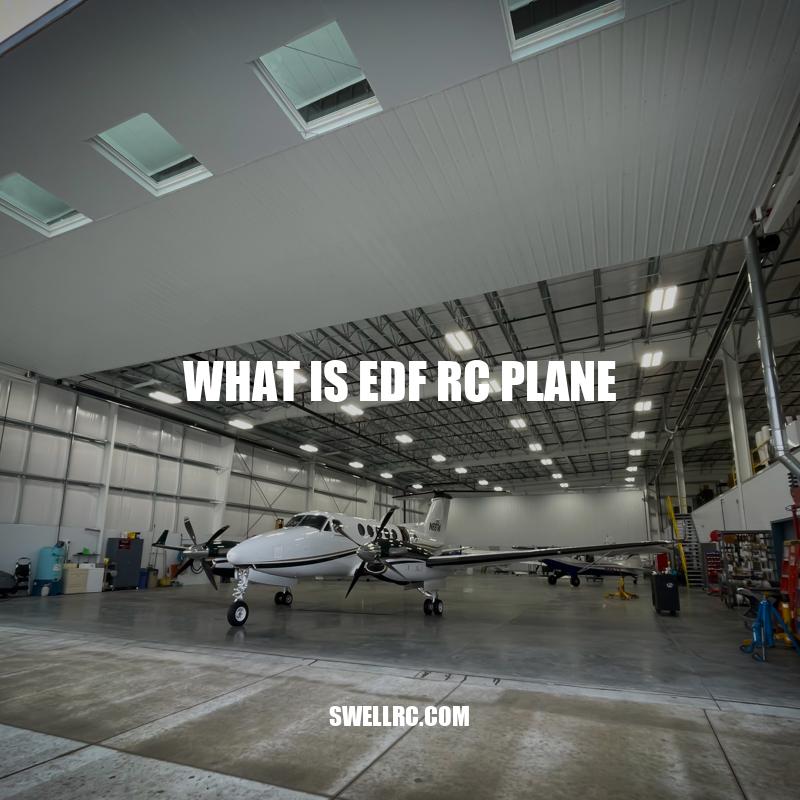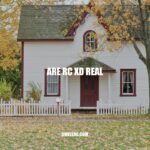Exploring EDF RC Planes: Advantages, Types, and Flying Tips
Electric Ducted Fan (EDF) RC planes have become increasingly popular in the world of remote-controlled (RC) aircraft. These planes utilize a specially-designed electric motor that drives a ducted fan mounted inside the airplane’s fuselage. EDF RC planes offer an array of benefits over traditional propeller-driven aircraft, including increased speed, improved efficiency, and quieter operation. Unlike propeller planes, an EDF creates a more uniform airflow over the entire model’s airframe, resulting in increased efficiency and power output. With fewer moving parts, EDF RC planes are also easier to maintain and can be less costly to repair over time. As such, EDF RC planes are ideal for people looking for a more engaging and exciting RC experience, without the added complexities of operating and maintaining traditional RC planes. Whether you’re a newcomer to the RC plane hobby or a seasoned pilot looking to try something new, an EDF RC plane is an excellent choice for anyone looking for a thrilling and high-performance flying experience.
How does an EDF RC plane work?
An EDF motor is a ducted fan powered by an electric motor mounted inside a tube, which forms the aircraft’s fuselage. The fan consists of a series of blades that draw air into the tube, compressing it and expelling it out the rear of the aircraft, thereby producing thrust. Some key differences between EDF motors and traditional propeller-driven systems include:
- EDF motors create a more uniform airflow over the airframe of the model, resulting in greater efficiency and power output.
- EDF motors are much quieter than propellers.
- EDF motors can produce more thrust than propellers of similar size.
The components of an EDF RC plane include the ducted fan unit, brushless electric motor, speed controller (ESC), battery, and receiver. The battery powers the motor and the ESC regulates the amount of power sent to the motor. The radio receiver translates inputs from the pilot’s remote control into commands for the aircraft, controlling its speed, altitude, and direction. If you’re looking to purchase an EDF RC plane, there are many options to choose from. Popular brands include HobbyKing, Motion RC, and Horizon Hobby. Beginners may want to consider the E-flite UMX MiG-15 or the FMS EDF version of the Easy Trainer, while more experienced pilots may prefer the Freewing F-22 Raptor or the Dynam Meteor.
What is an EDF motor?
An EDF (Electric Ducted Fan) motor is a type of propulsion system used primarily in remote control aircraft. It consists of an electric motor connected to a ducted fan that draws in air to generate thrust. Some benefits of EDF motors include high efficiency, low noise, and increased speed. They are commonly used in hobbyist RC planes and drones.
If you’re interested in purchasing an EDF motor, websites like Tower Hobbies and Horizon Hobby offer a range of options.
Advantages of an EDF RC plane
EDF RC planes have a number of advantages over traditional propeller planes. Some of these advantages include:
- Greater efficiency: Due to their design, EDF planes provide a more uniform flow of air over the wing’s surface. This results in less drag and turbulence, and greater lift at lower speeds
- Increased speed and power: EDF planes are capable of achieving high speeds and can generate more power than traditional propeller planes.
- Quieter performance: EDF planes create less noise than propeller planes thanks to the design of the ducted fan unit.
- Easier maintenance: Since EDF planes have fewer moving parts than traditional propeller planes, they require less maintenance overall. Additionally, it is easier to replace the ducted fan unit in the event of a crash.
One interesting fact about EDF planes is that they have become increasingly popular in recent years due to advancements in technology. Today’s EDF motors are more powerful and efficient than ever before, and are able to achieve speeds of over 100mph.
If you’re interested in purchasing or building your own EDF RC plane, there are many resources available online. Popular websites include HobbyKing, Motion RC, and Horizon Hobby, which offer a wide range of models and parts. Additionally, there are many online forums and communities dedicated to the hobby, where you can connect with other enthusiasts, share tips and tricks, and get advice on building and flying EDF planes.
Table of Popular EDF RC Planes
| Brand | Model | Level | Price Range |
|---|---|---|---|
| E-flite | UMX MiG-15 | Beginner | $100-$200 |
| FMS | Easy Trainer EDF | Beginner/Intermediate | $200-$300 |
| Freewing | F-22 Raptor | Intermediate/Advanced | $300-$400 |
| Dynam | Meteor | Intermediate/Advanced | $200-$300 |
What are the advantages of RC planes?
- RC planes can be flown in a variety of locations, such as parks and open fields, without the need for a runway or professional training.
- RC planes offer a unique perspective of the world, allowing the pilot to see their surroundings from a bird’s eye view.
- RC planes are a great way to develop hand-eye coordination and improve motor skills.
- RC plane models come in a variety of sizes and styles, ensuring that there is a plane for every type of pilot, from beginners to experts.
If you’re interested in getting started with RC planes, there are plenty of resources available online, including websites like Horizon Hobby and Tower Hobbies that offer a range of planes and accessories for all skill levels.
Types of EDF RC planes
EDF RC planes come in many different shapes and sizes, and are suitable for a wide range of skill levels. Some of the most popular types include:
Beginner EDF RC Planes
These planes are designed for those who are new to the hobby and are looking for an easy-to-fly model. Beginner EDFs typically have a lightweight, durable design, and are available in both indoor and outdoor versions. Some popular beginner EDF planes include:
- FMS Easy Trainer EDF
- E-flite UMX MiG-15
- HawkSky V2
Intermediate EDF RC Planes
These planes are ideal for those who have some experience flying RC planes, but are not yet ready for advanced models. Intermediate EDF planes typically have more advanced features and a higher level of performance than beginner planes. Some popular intermediate EDF planes include:
- FMS F-18 Hornet
- Dynam Meteor
- Skyflight LX F-35 Lightning II
Advanced EDF RC Planes
These planes are for experienced pilots who are looking for a challenge. Advanced EDF planes have the highest level of performance and are capable of achieving extremely high speeds. Some popular advanced EDF planes include:
- Freewing F-22 Raptor
- Flex Innovations FV-31 Cypher
- E-flite Viper 70mm EDF
If you’re interested in purchasing an EDF RC plane, there are many online retailers that offer a wide variety of models and parts. Popular websites include Motion RC, Horizon Hobby, and Grayson Hobby. Additionally, many RC plane enthusiasts recommend checking out forums and communities dedicated to the hobby, as they can provide valuable information and advice on finding the perfect EDF plane for your needs.
What does EDF mean for RC planes?
EDF stands for Electric Ducted Fan, which is a propulsion system used in RC planes. Instead of a traditional propeller, an EDF system uses a fan inside a duct to move air and create thrust.
Benefits of EDF systems for RC planes include improved speed, smoother and quieter operation, and a more streamlined look. They are also more efficient than traditional propellers and can produce higher thrust-to-weight ratios.
There are many websites and products available for those interested in EDF RC planes, including hobby shops and online retailers such as HobbyKing and RC Groups.
Building an EDF RC Plane
One of the benefits of EDF RC planes is the ability to build and customize your own model. While building an EDF RC plane may seem daunting, there are many resources available online to help guide you through the process.
Parts Needed for Building an EDF RC Plane
Before you begin building your EDF RC plane, here are the parts you will need:
- EDF unit
- Motor
- Battery
- Electronic speed controller (ESC)
- Servo motors
- Transmitter and receiver
- Building materials (foam, balsa wood, carbon fiber, etc.)
- Tools (glue, scissors, hobby knife, etc.)
Building Approaches
There are two main approaches to building an EDF RC plane: building from a kit or building from scratch.
If you’re new to building planes, starting with a kit may be the easiest option. EDF RC plane kits come with most of the necessary components and often include detailed instructions to guide you through the building process. Some popular EDF RC plane kits include:
- FMS BAE Hawk EDF Jet
- Dynam Meteor EDF Jet
- Dynam Devil 3D EDF Jet
If you’re experienced in building planes, you may want to consider building from scratch. This will give you more control over the design and performance of your plane, but requires more time and skill.
Building Tips
Here are some tips to help ensure a successful EDF RC plane build:
- Research and plan ahead
- Use quality materials
- Take your time and be patient
- Double-check your work before flying
- Start with a smaller model for your first build
In addition to purchasing kits and components from retailers, there are also many online resources available to help with building an EDF RC plane. Websites like RC Groups and Flite Test offer forums and tutorials on building and customizing models.
What do I need to build an RC plane?
To build an RC plane, you will need the following items:
- A kit or plans for the type of plane you want to build
- Balsa wood or other materials for construction
- A motor, propeller, and speed controller
- A radio transmitter and receiver
- Servos for controlling the plane’s movements
- Battery and battery charger
- Tools such as a hobby knife, sandpaper, and pliers
You can find all of these items at your local hobby shop or online retailers such as HobbyKing or Tower Hobbies. Additionally, RCGroups.com is a great resource for finding plans, advice and connecting with other RC plane enthusiasts.
Flying an EDF RC Plane
Flying an EDF RC plane can be a thrilling experience, but it’s important to prioritize safety and follow proper flying techniques.
Safety Precautions
Before taking your EDF RC plane out for a spin, here are a few safety considerations:
- Choose a wide, open area without obstructions or people nearby
- Check the weather conditions to ensure safe flying
- Perform a pre-flight inspection to make sure all components are functioning properly
- Wear eye protection to prevent injury from flying debris
Flying Techniques
Successfully flying an EDF RC plane requires practice and technique. Here are some tips to help you improve your skills:
- Start with small, slow movements to avoid losing control of the plane
- Practice smooth, coordinated turns
- Use the throttle to control altitude and speed
- Be aware of the plane’s orientation and adjust accordingly
- Practice landing techniques to avoid crashes
Maneuvers
Once you’ve mastered basic flying techniques, you can try out some more advanced maneuvers. Here are a few popular ones:
- Rolls – rotating the plane along its longitudinal axis
- Loops – flying the plane in a circular pattern
- Immelmanns – half roll and half loop in one direction followed by the same move in the opposite direction
- Split-S – half roll, half loop in the opposite direction of an Immelmann
- Inverted flight – flying the plane upside down
As with building an EDF RC plane, there are many online resources available for improving your flying skills. Websites like RC Universe and RC Groups offer forums and tutorials on flying techniques and maneuvers. Additionally, instructional videos on social media platforms like YouTube can also be helpful.
What is the best EDF RC plane for beginners?
- The F-16 Falcon is a great starter EDF RC plane for beginners. It is small, lightweight and easy to handle, making it perfect for learning the basics of flying RC planes.
- The E-flite F-15 Eagle is another good option for beginners due to its stability and ease of control.
- For those on a tight budget, the HobbyZone Mini Apprentice S is a great option that is easy to fly and comes at an affordable price point.
If you’re interested in purchasing any of these planes, check out websites such as Horizon Hobby or RC Planet for a range of options and prices.
Conclusion
EDF RC planes bring a new level of speed, efficiency, and power to the world of RC planes. These planes offer a thrilling and rewarding experience for hobbyists of all experience levels. Whether you’re building your own plane or purchasing one ready-to-fly, there are numerous options and styles available to cater to your needs and preferences. With proper safety precautions and technique, flying an EDF RC plane can be an exciting adventure.
Where to Find EDF RC Planes
There are many options available when it comes to purchasing EDF RC planes. Here are a few popular sources:
- Horizon Hobby
- HobbyKing
- Banggood
- E-flite
Check out these retailers for a wide range of EDF RC planes from beginner to advanced level, as well as accessories and parts for building and maintaining your EDF RC plane.
Overall, EDF RC planes offer an exhilarating and unique experience for RC plane enthusiasts. With proper research, practice, and safety precautions, building and flying an EDF RC plane can provide hours of fun and excitement.



